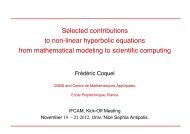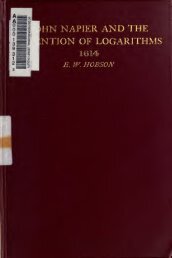The construction of the wonderful canon of logarithms
The construction of the wonderful canon of logarithms
The construction of the wonderful canon of logarithms
Create successful ePaper yourself
Turn your PDF publications into a flip-book with our unique Google optimized e-Paper software.
Notes. 85<br />
On some Terms made use <strong>of</strong> in <strong>the</strong> Original Work.<br />
Napier's Canon or Table <strong>of</strong> Logarithms does not contain <strong>the</strong><br />
<strong>logarithms</strong> <strong>of</strong> equidifferent numbers, but <strong>of</strong> sines <strong>of</strong> equidifferent arcs<br />
for every minute in <strong>the</strong> quadrant. A specimen page <strong>of</strong> <strong>the</strong> Table is<br />
given in <strong>the</strong> Catalogue under <strong>the</strong> 1614 edition <strong>of</strong> <strong>the</strong> Descriptio.<br />
<strong>The</strong> sine <strong>of</strong> <strong>the</strong> Quadrant or Radius, which he calls Sinus Totus, was<br />
assumed to have <strong>the</strong> value 1 0000000.<br />
Numerus Artificialis, or simply Artifidalis, is used in <strong>the</strong> body <strong>of</strong> <strong>the</strong><br />
Constructio for Logarithm, <strong>the</strong> number corresponding to <strong>the</strong> logarithm<br />
being called NumefTis Naturalis.<br />
Logarithmus, corresponding to which Numerus Vulgaris is used, is<br />
however employed in <strong>the</strong> title-page and headings <strong>of</strong> <strong>the</strong> Constructio, and<br />
in <strong>the</strong> Appendix and following papers. It is also used throughout <strong>the</strong><br />
Descriptio published in<br />
1614; and as <strong>the</strong> word was not invented till<br />
several years after <strong>the</strong> completion <strong>of</strong> <strong>the</strong> Constructio (see <strong>the</strong> second<br />
page <strong>of</strong> <strong>the</strong> Preface, line 12), <strong>the</strong> latter must have been written some<br />
years prior to 16 14.<br />
For shortness, Napier sometimes uses <strong>the</strong> expression logarithm<br />
arc for <strong>the</strong> logarithm <strong>of</strong> <strong>the</strong> sine <strong>of</strong> an arc.<br />
<strong>of</strong> an<br />
<strong>The</strong> Antilogarithm <strong>of</strong> an arc, meaning log. sine complement <strong>of</strong> arc,<br />
and <strong>the</strong> Differential <strong>of</strong> an arc, meaning log. tangent <strong>of</strong> arc (see Descriptio,<br />
Bk. I., chap, iii.), are terms used in <strong>the</strong> original, but as <strong>the</strong>y<br />
have a different signification in modern ma<strong>the</strong>matics, we do not use<br />
<strong>the</strong>m in <strong>the</strong> translation.<br />
Prosthapharesis was a term in common use at<br />
<strong>the</strong> beginning <strong>of</strong> <strong>the</strong><br />
seventeenth century, and is twice employed by Napier in <strong>the</strong> Spherical<br />
Trigonometry <strong>of</strong> <strong>the</strong> Constructio as well as in <strong>the</strong> Descriptio. <strong>The</strong><br />
following short extract from Mr Glaisher's article on Napier, in <strong>the</strong><br />
'<br />
Encyclopedia Britannica,' indicates <strong>the</strong> nature <strong>of</strong> this method <strong>of</strong><br />
calculation.<br />
<strong>The</strong> ' ' new invention in Denmark " to which Anthony Wood refers as having<br />
given <strong>the</strong> hint to Napier was probably <strong>the</strong> method <strong>of</strong> calculation called<br />
prosthaphaeresis (<strong>of</strong>ten written in Greek letters irpotrOaipaipetns), which had its<br />
origin in <strong>the</strong> solution <strong>of</strong> spherical triangles. <strong>The</strong> method consists in <strong>the</strong> use <strong>of</strong><br />
<strong>the</strong> formula sin a sin 6 = ^ {cos {a-b)- cos (a + b)}, by means <strong>of</strong> which <strong>the</strong> multiplication<br />
<strong>of</strong> two sines is reduced to <strong>the</strong> addition or subtraction <strong>of</strong> two tabular<br />
results taken from a table <strong>of</strong> sines ; and as such products occur in <strong>the</strong> solution


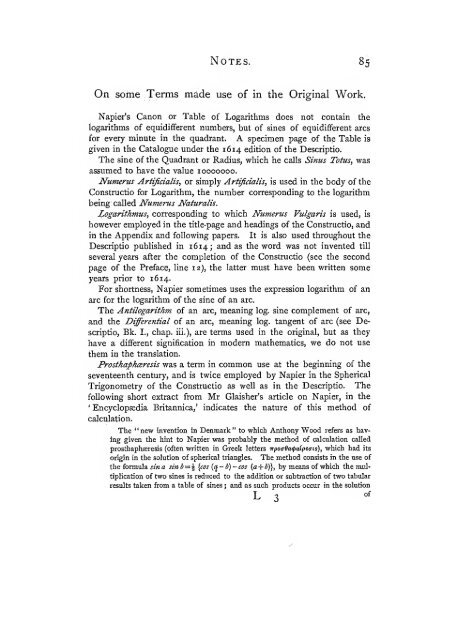
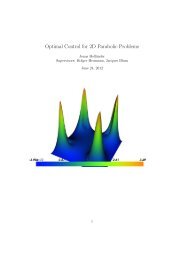
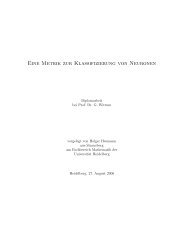
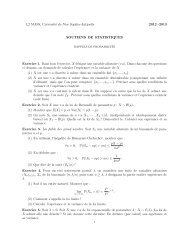
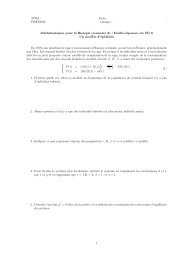


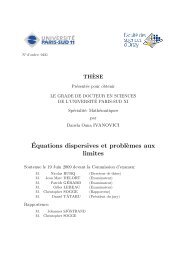
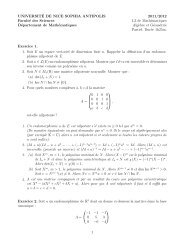
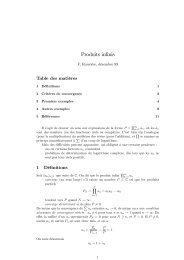
!['eries enti\`eres (+ [D78 Th d'Abel angulaire])](https://img.yumpu.com/14067031/1/184x260/eries-entieres-d78-th-dabel-angulaire.jpg?quality=85)
